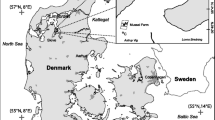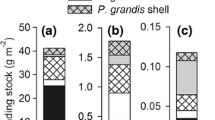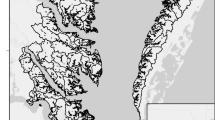Abstract
The mutualism between Spartina alterniflora (Smooth Cordgrass) and Geukensia demissa (Ribbed Mussels) can increase ecosystem services, including the removal of excess nitrogen via denitrification. However, different responses of these species to sea-level rise and eutrophication can cause mussel beds to persist in areas where cordgrass has been lost to erosion and excessive tidal inundation. The function of these remnant mussel beds, in the absence of cordgrass mutualists, remains unclear. In this study, we sampled an eroding salt marsh in Jamaica Bay (NY, USA) to determine mussel density and size in non-vegetated mussel beds and vegetated marsh. We also collected sediment cores from remnant mussel beds and adjacent mudflats (i.e., former marsh) and performed continuous-flow core incubations to measure benthic nutrient fluxes, sediment oxygen demand, and denitrification. We found that remnant mussel beds were dominated by larger mussels compared to vegetated beds, which suggests less recruitment to remnant beds. In contrast to previous studies, which have found positive effects of mussels on denitrification, we found similar rates in mussel beds and mudflats. Sediment oxygen demand was also higher in remnant mussel beds suggesting that sediments may become more reduced due to mussel respiration. Our study suggests that the presence of mussels does not enhance, and may inhibit, nitrogen removal in eroded marsh sediments.





Similar content being viewed by others
Data availability
The datasets generated during and/or analyzed during the current study are available from the corresponding author on reasonable request.
References
Alldred M, Liberti A, Baines SB (2017) Impact of salinity and nutrients on salt marsh stability. Ecosphere 8(11):e02010. https://doi.org/10.1002/ecs2.2010
Alldred M, Borrelli JJ, Hoellein T, Bruesewitz D, Zarnoch C (2020) Marsh plants enhance coastal marsh resilience by changing sediment oxygen and sulfide concentrations in an urban, eutrophic estuary. Estuaries Coasts 43(4):801–813. https://doi.org/10.1007/s12237-020-00700-9
American Public Health Association (APHA) (1998) Standard methods for the examination of water and wastewater. Baltimore
Aspila KI, Agemian H, Chau ASY (1976) A semi-automated method for the determination of inorganic, organic and total phosphate in sediments. Analyst 101(1200):187–197. https://doi.org/10.1039/AN9760100187
Ayvazian S, Mulvaney K, Zarnoch C, Palta M, Reichert-Nguyen J, McNally S, Pilaro M, Jones A, Terry C, Fulweiler RW (2021) Beyond bioextraction: the role of oyster-mediated denitrification in nutrient management. Environ Sci Technol 55(21):14457–14465
Benotti MJ, Brownawell BJ (2007) Distributions of pharmaceuticals in an urban estuary during both dry-and wet-weather conditions. Environ Sci Technol 41(16):5795–5802. https://doi.org/10.1021/es0629965
Bertness MD (1984) Ribbed mussels and Spartina alterniflora production in a New England salt marsh. Ecology 65(6):1794–1807. https://doi.org/10.2307/1937776
Bertness MD, Grosholz E (1985) Population dynamics of the ribbed mussel, Geukensia demissa: the costs and benefits of an aggregated distribution. Oecologia 67(2):192–204. https://doi.org/10.1007/BF00384283
Bilkovic DM, Mitchell MM, Isdell RE, Schliep M, Smyth AR (2017) Mutualism between ribbed mussels and cordgrass enhances salt marsh nitrogen removal. Ecosphere 8(4):e01795. https://doi.org/10.1002/ecs2.1795
Bilkovic DM, Isdell RE, Guthrie AG, Mitchell MM, Chambers RM (2021) Ribbed mussel Geukensia demissa population response to living shoreline design and ecosystem development. Ecosphere 12(3):e03402. https://doi.org/10.1002/ecs2.3402
Bowen JL, Giblin AE, Murphy AE, Bulseco AN, Deegan LA, Johnson DS, Sullivan HL (2020) Not all nitrogen is created equal: differential effects of nitrate and ammonium enrichment in coastal wetlands. Bioscience 70(12):1108–1119. https://doi.org/10.1093/biosci/biaa140
Cahoon DR, Lynch JC, Roman CT, Schmit JP, Skidds DE (2019) Evaluating the relationship among wetland vertical development, elevation capital, sea-level rise, and tidal marsh sustainability. Estuaries Coasts 42(1):1–15. https://doi.org/10.1007/s12237-018-0448-x
Campbell A, Wang Y, Christiano M, Stevens S (2017) Salt marsh monitoring in Jamaica Bay, New York from 2003 to 2013: a decade of change from restoration to Hurricane Sandy. Remote Sens 9(2):131. https://doi.org/10.3390/rs9020131
Chintala MM, Wigand C, Thursby G (2006) Comparison of Geukensia demissa populations in Rhode Island fringe salt marshes with varying nitrogen loads. Mar Ecol Prog Ser 320:101–108. https://doi.org/10.3354/meps320101
Cornwell JC, Owens MS, Staver LW (2022) Nutrient retention and release in eroding Chesapeake bay tidal wetlands. JAWRA J Am Water Resour Assoc. https://doi.org/10.1111/1752-1688.12984
Day JW, DeLaune RD, White JR, Lane RR, Hunter RG, Shaffer GP (2018) Can denitrification explain coastal wetland loss: a review of case studies in the Mississippi Delta and New England. Estuar Coast Shelf Sci 213:294–304. https://doi.org/10.1016/j.ecss.2018.08.029
Deegan LA, Johnson DS, Warren RS, Peterson BJ, Fleeger JW, Fagherazzi S, Wollheim WM (2012) Coastal eutrophication as a driver of salt marsh loss. Nature 490(7420):388–392. https://doi.org/10.1038/nature11533
Derksen-Hooijberg M, van der Heide T, Lamers LP, Borst A, Smolders AJ, Govers LL, Angelini C (2019) Burrowing crabs weaken mutualism between foundation species. Ecosystems 22(4):767–780. https://doi.org/10.1007/s10021-018-0301-x
Franz DR (2001) Recruitment, survivorship, and age structure of a New York ribbed mussel population (Geukensia demissa) in relation to shore level: a nine year study. Estuaries 24(3):319–327. https://doi.org/10.2307/1353234
Fulweiler RW, Brown SM, Nixon SW, Jenkins BD (2013) Evidence and a conceptual model for the co-occurrence of nitrogen fixation and denitrification in heterotrophic marine sediments. Mar Ecol Prog Ser 482:57–68. https://doi.org/10.3354/meps10240
Gardner WS, McCarthy MJ (2009) Nitrogen dynamics at the sediment–water interface in shallow, sub-tropical Florida Bay: why denitrification efficiency may decrease with increased eutrophication. Biogeochemistry 95(2):185–198. https://doi.org/10.1007/s10533-009-9329-5
Giblin AE, Tobias CR, Song B, Weston N, Banta GT, Rivera-Monroy H (2013) The importance of dissimilatory nitrate reduction to ammonium (DNRA) in the nitrogen cycle of coastal ecosystems. Oceanography 26(3):124–131
Groffman PM, Altabet MA, Böhlke H, Butterbach-Bahl K, David MB, Firestone MK, Voytek MA (2006) Methods for measuring denitrification: diverse approaches to a difficult problem. Ecol Appl 16(6):2091–2122. https://doi.org/10.1890/1051-0761(2006)016[2091:MFMDDA]2.0.CO;2
Hartig EK, Gornitz V (2004) Salt marsh change, 1926–2002 at Marshlands Conservancy, New York. In: Proceedings of the Long Island Sound Biennial Research Conference
Hartig EK, Gornitz V, Kolker A, Mushacke F, Fallon D (2002) Anthropogenic and climate-change impacts on salt marshes of Jamaica Bay. NY City Wetl 22(1):71–89. https://doi.org/10.1672/0277-5212(2002)022[0071:AACCIO]2.0.CO;2
Hinshaw SE, Tatariw C, Flournoy N, Kleinhuizen A, Taylor C, Sobecky PA, Mortazavi B (2017) Vegetation loss decreases salt marsh denitrification capacity: implications for marsh erosion. Environ Sci Technol 51(15):8245–8253. https://doi.org/10.1021/acs.est.7b00618
Hoellein TJ, Zarnoch CB (2014) Effect of eastern oysters (Crassostrea virginica) on sediment carbon and nitrogen dynamics in an urban estuary. Ecol Appl 24(2):271–286. https://doi.org/10.1890/12-1798.1
Isdell RE, Bilkovic DM, Hershner C (2018) Shorescape-level factors drive distribution and condition of a salt marsh facilitator (Geukensia demissa). Ecosphere 9(10):e02449. https://doi.org/10.1002/ecs2.2449
Jackson M, Owens MS, Cornwell JC, Kellogg ML (2018) Comparison of methods for determining biogeochemical fluxes from a restored oyster reef. PLoS ONE 13(12):e0209799. https://doi.org/10.1371/journal.pone.0209799
Kana TM, Darkangelo C, Hunt MD, Oldham JB, Bennett GE, Cornwell JC (1994) Membrane inlet mass spectrometer for rapid high-precision determination of N2, O2, and Ar in environmental water samples. Anal Chem 66(23):4166–4170. https://doi.org/10.1021/ac00095a009
Koop-Jakobsen K, Giblin AE (2010) The effect of increased nitrate loading on nitrate reduction via denitrification and DNRA in salt marsh sediments. Limnol Oceanogr 55(2):789–802. https://doi.org/10.4319/lo.2010.55.2.0789
Leonard LA, Croft AL (2006) The effect of standing biomass on flow velocity and turbulence in Spartina alterniflora canopies. Estuar Coast Shelf Sci 69(3–4):325–336. https://doi.org/10.1016/j.ecss.2006.05.004
Marcarelli AM, Fulweiler RW, Scott JT (2022) Nitrogen fixation: a poorly understood process along the freshwater-marine continuum. Limnol Oceanogr Lett 7(1):1–10. https://doi.org/10.1002/lol2.10220
Murphy J, Riley JP (1962) A modified single solution method for the determination of phosphate in natural waters. Anal Chim Acta 27:31–36. https://doi.org/10.1016/S0003-2670(00)88444-5
Murphy AE, Anderson IC, Smyth AR, Song B, Luckenbach MW (2016) Microbial nitrogen processing in hard clam (Mercenaria mercenaria) aquaculture sediments: the relative importance of denitrification and dissimilatory nitrate reduction to ammonium (DNRA). Limnol Oceanogr 61(5):1589–1604. https://doi.org/10.1002/lno.10305
Neubacher EC, Parker RE, Trimmer M (2011) Short-term hypoxia alters the balance of the nitrogen cycle in coastal sediments. Limnol Oceanogr 56(2):651–665. https://doi.org/10.4319/lo.2011.56.2.0651
Nielsen KJ, Franz DR (1995) The influence of adult conspecifics and shore level on recruitment of the ribbed mussel Geukensia demissa (Dillwyn). J Exp Mar Biol Ecol 188(1):89–98. https://doi.org/10.1016/0022-0981(94)00190-O
Nieuwenhuize J, Maas YE, Middelburg JJ (1994) Rapid analysis of organic carbon and nitrogen in particulate materials. Mar Chem 45(3):217–224. https://doi.org/10.1016/0304-4203(94)90005-1
Peteet DM, Nichols J, Kenna T, Chang C, Browne J, Reza M, Stern-Protz S (2018) Sediment starvation destroys New York City marshes’ resistance to sea level rise. Proc Natl Acad Sci 115(41):10281–10286. https://doi.org/10.1073/pnas.1715392115
Prins TC, Smaal AC (1994) The role of the blue mussel Mytilus edulis in the cycling of nutrients in the Oosterschelde estuary (The Netherlands). Hydrobiologia 282:413–429. https://doi.org/10.1007/BF00024645
Rosenzweig BR, Groffman PM, Zarnoch CB, Branco BF, Hartig EK, Fitzpatrick J, Parris A (2018) Nitrogen regulation by natural systems in “unnatural” landscapes: denitrification in ultra-urban coastal ecosystems. Ecosyst Health Sustain 4(9):205–224. https://doi.org/10.1080/20964129.2018.1527188
Rossi RE, Schutte CA, Logarbo J, Bourgeois C, Roberts BJ (2022) Gulf ribbed mussels increase plant growth, primary production, and soil nitrogen cycling potential in salt marshes. Mar Ecol Prog Ser 689:33–46. https://doi.org/10.3354/meps14032
Sarà G (2006) Hydrodynamic effects on the origin and quality of organic matter for bivalves: an integrated isotopic, biochemical and transplant study. Mar Ecol Prog Ser 328:65–73. https://doi.org/10.3354/meps328065
Schlaepfer MA, Runge MC, Sherman PW (2002) Ecological and evolutionary traps. Trends Ecol Evol 17(10):474–480. https://doi.org/10.1016/S0169-5347(02)02580-6
Shantz AA, Lemoine NP, Burkepile DE (2016) Nutrient loading alters the performance of key nutrient exchange mutualisms. Ecol Lett 19(1):20–28. https://doi.org/10.1111/ele.12538
Solorzano L (1969) Determination of ammonia in natural waters by the phenol hypochlorite method. Limnol Oceanogr 14(5):799–801. https://doi.org/10.4319/lo.1969.14.5.0799
Spiteri C, Van Cappellen P, Regnier P (2008) Surface complexation effects on phosphate adsorption to ferric iron oxyhydroxides along pH and salinity gradients in estuaries and coastal aquifers. Geochim Cosmochim Acta 72(14):3431–3445. https://doi.org/10.1016/j.gca.2008.05.003
Vieillard AM, Fulweiler RW (2012) Impacts of long-term fertilization on salt marsh tidal creek benthic nutrient and N2 gas fluxes. Mar Ecol Prog Ser 471:11–22. https://doi.org/10.3354/meps10013
Wallace RB, Gobler CJ (2015) Factors controlling blooms of microalgae and macroalgae (Ulva rigida) in a eutrophic, urban estuary: Jamaica Bay, NY, USA. Estuaries Coasts 38(2):519–533. https://doi.org/10.1007/s12237-014-9818-1
Wallace RB, Baumann H, Grear JS, Aller RC, Gobler CJ (2014) Coastal ocean acidification: the other eutrophication problem. Estuar Coast Shelf Sci 148:1–13. https://doi.org/10.1016/j.ecss.2014.05.027
Watson EB, Oczkowski AJ, Wigand C, Hanson AR, Davey EW, Crosby SC, Andrews HM (2014) Nutrient enrichment and precipitation changes do not enhance resiliency of salt marshes to sea level rise in the Northeastern US. Clim Change 125(3):501–509. https://doi.org/10.1007/s10584-014-1189-x
Watson EB, Wigand C, Davey EW, Andrews HM, Bishop J, Raposa KB (2017) Wetland loss patterns and inundation-productivity relationships prognosticate widespread salt marsh loss for southern New England. Estuaries Coasts 40(3):662–681. https://doi.org/10.1007/s12237-016-0069-1
Watt C, Garbary DJ, Longtin C (2011) Population structure of the ribbed mussel Geukensia demissa in salt marshes in the southern Gulf of St. Lawrence, Canada. Helgol Mar Res 65(3):275–283. https://doi.org/10.1007/s10152-010-0221-4
Whaley T, Alldred M (2023) A Meta-analysis Reveals Knowledge Gaps in Our Understanding of the Spartina-Geukensia Mutualism. Estuaries Coasts. https://doi.org/10.1007/s12237-023-01194-x
Wigand C, Roman CT, Davey E, Stolt M, Johnson R, Hanson A, Rafferty P (2014) Below the disappearing marshes of an urban estuary: historic nitrogen trends and soil structure. Ecol Appl 24(4):633–649. https://doi.org/10.1890/13-0594.1
Yoo JH, Ro HM, Choi WJ, Yoo SH, Han KH (2006) Phosphorus adsorption and removal by sediments of a constructed marsh in Korea. Ecol Eng 27(2):109–117. https://doi.org/10.1016/j.ecoleng.2005.12.001
Zarnoch CB, Schreibman M (2012) Growth and reproduction of eastern oysters, Crassostrea virginica in a New York City estuary: implications for restoration. Urban habitats 7(1)
Zhu J, Zarnoch C, Gosnell JS, Alldred M, Hoellein T (2019) Ribbed mussels Geukensia demissa enhance nitrogen-removal services but not plant growth in restored eutrophic salt marshes. Mar Ecol Prog Ser 631:67–80. https://doi.org/10.3354/meps13132
Acknowledgements
The authors appreciate support from the Hudson River Foundation (Grant # 013/15A) and a PSC-CUNY Award (# 69770-00 47). A portion of the study data was generated through a course-based undergraduate research experience (CURE) in a “Biology of Invertebrates” course at Baruch College CUNY. The authors would like to thank the undergraduates who contributed to the data collection. B.G. was supported by the CUNY College Now Program. L.B. and P.L. were supported by Pinkerton Science Scholars Program (Pinkerton Foundation) and the NYC Science Research Mentoring Consortium led by the American Museum of Natural History.
Funding
The authors appreciate support from the Hudson River Foundation (Grant # 013/15A) and a PSC-CUNY Award (# 69770-00 47). B.G. was supported by the CUNY College Now Program. L.B. and P.L. were supported by the Pinkerton Science Scholars Program (Pinkerton Foundation) and the NYC Science Research Mentoring Consortium led by the American Museum of Natural History.
Author information
Authors and Affiliations
Contributions
All authors contributed to the study conception and design. Material preparation, data collection and analysis were performed by all authors. The first draft of the manuscript was written by ATA and CBZ. MA, AC, and LB commented on previous versions of the manuscript. All authors read and approved the final manuscript.
Corresponding author
Ethics declarations
Competing interests
The authors have no relevant financial or non-financial interests to disclose.
Ethical approval
Not applicable.
Additional information
Publisher's Note
Springer Nature remains neutral with regard to jurisdictional claims in published maps and institutional affiliations.
Rights and permissions
Springer Nature or its licensor (e.g. a society or other partner) holds exclusive rights to this article under a publishing agreement with the author(s) or other rightsholder(s); author self-archiving of the accepted manuscript version of this article is solely governed by the terms of such publishing agreement and applicable law.
About this article
Cite this article
Abbas, A.T., Cardenas, A., LaFond, D. et al. Loss of salt marsh plants impacts ribbed mussel (Geukensia demissa) size, density, and influence on sediment nitrogen cycling. Wetlands Ecol Manage 31, 367–380 (2023). https://doi.org/10.1007/s11273-023-09921-8
Received:
Accepted:
Published:
Issue Date:
DOI: https://doi.org/10.1007/s11273-023-09921-8




